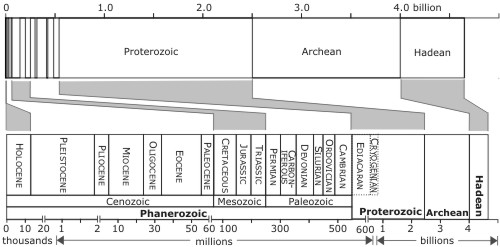What is the best way to represent geological time? When I was working on my little timescale project, I had one very specific aim in mind: I wanted a scale that clearly showed the names and ages of all the different geological periods, without becoming ridiculously big. As it turns out, this isn’t very easy. From a temporal perspective the divisions of the timescale are somewhat irregular, ranging from tens of thousands of years in length (the Holocene) to a couple of billion (the Proterozoic). In fact, if you plot the entire 4600 million years of Earth history linearly, even the periods which last tens of millions of years, which is most of them, are pretty narrow.

You can see from the comparison that my timescale significantly expands the last 600 million years at the expense of the preceding 4000 million, which certainly hides the full extent to which the entire period of macroscopic life (the Phanerozoic) is a pretty new development as far as the Earth is concerned. However, in return for this sacrifice it is now possible to see exactly when a geologist is talking about when he talks about the Silurian.
As a linear scale clearly doesn’t fit our purpose, the observation that the further back we go, the longer the absolute length of the different periods seems to get immediately brings to mind a logarithmic scale. As it turns out, this doesn’t really work either; the last 20 million years of geological history manages to crowd out pretty much everything else, which may be great for the hominid-centric among us but is hardly very useful for the rest of us (I note with some amusement that a young earth creationist chronology is compressed into nothingness off the left of this scale – how apt).

Clearly, the ideal scaling lies between those two extremes, which is what eventually led me to my multiply-rescaling linear axis. It occurs to me that, in a way, the need for such fudging tells us something quite important about the way the geological timescale has come to be. It’s based on something other than a striving for mathematical neatness; indeed, given that divisions such as the Cambrian and Devonian were first created almost a century before we were able to assign them absolute ages with any degree of certainly, that’s impossible. Instead, as geologists have tried to write the Earth’s biography, they’ve divided up the timescale in a phenomenological manner: each period represents a time in earth history with a distinctive tectonic, climatic, geochemical and biological ‘flavour’. Thus there is no maximum or minimum limit on how long these different chapters can last; also, as we go further back in time, the accuracy of our information is diminished, meaning that we can’t go into as much detail as we can for more recent events, and the divisions become wider.
The idea that geologists are writing Earth’s biography is quite a useful one for understanding the structure of the timescale they have created. When reading someone’s biography, it’s noticable that the different phases of somebody’s life can cover markedly different lengths of time, with hugely important and influential events getting their own chapter even though they may only actually last a few weeks or months. Likewise, the childhood of a famous person is described in a much less detailed manner than his later life, not because this time was necessarily any less eventful or important, but simply due to limited sources; instead of multiple eyewitness accounts, newspaper articles, and TV and radio recordings, all biographers may have to go on is the rememberances of a geriatric former schoolteacher, who may or may not be actually recalling the antics of the specific young lad or lass that you’re interested in.
As it is for people, so it is for the Earth; and so, also, it is for my timescale. I don’t deny that grasping the true depths of Deep Time is important (indeed, it’s essential if we’re ever going to create a sustainable civilisation), but I think getting to grips with the different chapters of geological history, where different events fall in the narrative, and their sequence, is also an important part of understanding the planet we live on. That’s what I’m trying to aid with my rather warped little plot; whether it helps, or hinders, remains to be seen. Either way, I appreciate the encouragement and/or feedback you’ve all been giving me, so please keep doing so.



Comments (16)